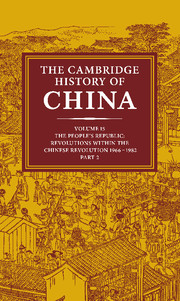Book contents
- Frontmatter
- 1 Mao Tse-tung's thought from 1949 to 1976
- PART I THE CULTURAL REVOLUTION: CHINA IN TURMOIL, 1966–1969
- PART II THE CULTURAL REVOLUTION: THE STRUGGLE FOR THE SUCCESSION, 1969–1982
- PART III THE CULTURAL REVOLUTION AND ITS AFTERMATH
- PART IV LIFE AND LETTERS UNDER COMMUNISM
- PART V THE SEPARATED PROVINCE
- Epilogue: the onus of unity
- Appendixes: meetings and leaders
- Bibliographical essays
- Bibliography
- Index
- Map 1: China’s physical features
- Map 2. PRC: political (Wade–Giles romanization)
- Map 3. PRC: political (pinyin romanization)
- Map 7: Population
Epilogue: the onus of unity
Published online by Cambridge University Press: 28 March 2008
- Frontmatter
- 1 Mao Tse-tung's thought from 1949 to 1976
- PART I THE CULTURAL REVOLUTION: CHINA IN TURMOIL, 1966–1969
- PART II THE CULTURAL REVOLUTION: THE STRUGGLE FOR THE SUCCESSION, 1969–1982
- PART III THE CULTURAL REVOLUTION AND ITS AFTERMATH
- PART IV LIFE AND LETTERS UNDER COMMUNISM
- PART V THE SEPARATED PROVINCE
- Epilogue: the onus of unity
- Appendixes: meetings and leaders
- Bibliographical essays
- Bibliography
- Index
- Map 1: China’s physical features
- Map 2. PRC: political (Wade–Giles romanization)
- Map 3. PRC: political (pinyin romanization)
- Map 7: Population
Summary
In the preface to Volume 14, we said that a rounded perspective on the Communist enterprise in China might be possible only after a century. An epilogue appended to the final volume of a history of China covering two thousand years is a hazardous venture. Yet to take our narrative so close to the present and not offer some contemporary reflections seems craven, even if the result will only provide harmless amusement for future historians.
In our introduction to these final two volumes, entitled "The Reunification of China," we pointed out that "a billion or so Europeans in Europe and the Americas live divided into some fifty separate and sovereign states, while more than a billion Chinese live in only one state." We rejected geography and ethnic diversity as sufficient explanations for the failure of Europeans to revive the Roman empire, as compared with the success of the Chinese in restoring theirs. We argued, rather, that the disorder of the Warring States period (403-221 B.C.) led Chinese political philosophers such as Confucius to enshrine peace and order as central ideals, thus transforming unity into an overriding political goal. Once achieved, unity was preserved by the invention of bureaucratic government. The bureaucracy's function was facilitated by the unifying symbol of the emperor and legitimized by a universal ideology of which it was the guardian.
- Type
- Chapter
- Information
- The Cambridge History of China , pp. 875 - 882Publisher: Cambridge University PressPrint publication year: 1991

